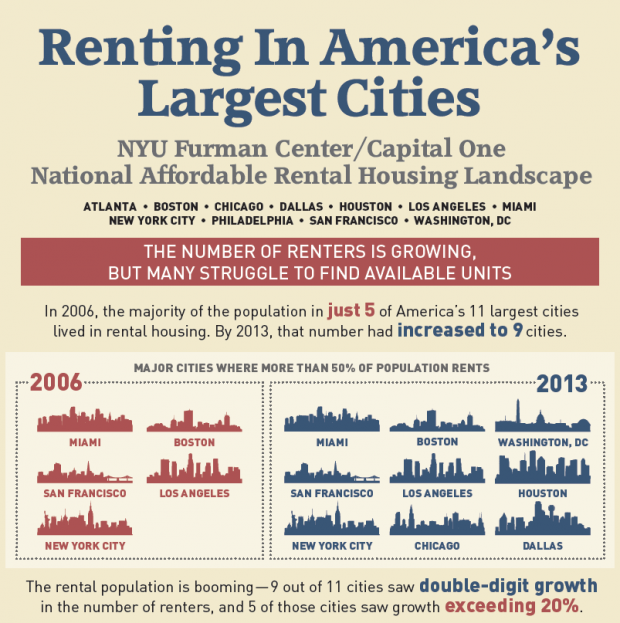A report by New York University’s Furman Center found that renters made up the majority of households in nine of the 11 largest cities in the U.S. in 2013, up from five in 2006. The demand is straining the supply of rental housing.
The report, produced with Capital One's "Investing for Good" subsidiary, "found a significant shift in the proportion of renters in all major cities—even in lower-density, relatively inexpensive places such as Houston and Dallas," write Wall Street Journal reporters Laura Kusisto and Kris Hudson.

One surprising outlier was the nation's largest city, which "no longer has the largest share of renters of any of the big cities, having been outstripped by Miami, where 65% of the population rents, a percentage point higher than New York [see Wall Street Journal graphic]," write Kusisto and Hudson. New York "is also one of several where the percentage of renters has been on a long-term decline, falling from 71% in 1970 to 64% in 2013."
Causes for the major uptick in renting nationwide varies. In some, "long-term demographic trends and changing attitudes have diminished the appeal of the traditional American dream of homeownership," they write. "But for many, slow income growth and a lack of savings are the main reasons for renting instead of buying, even as mortgage rates remain historically low."
The implications on affordable housing was one of the main findings of the report. "As the number of renters grow, if the supply of rental housing does not keep up—as it has not in most of these cities—then vacancy rates will fall, rents will rise, and more renters will struggle with the costs of housing," said Ingrid Gould Ellen, the Furman Center’s faculty director.
The report found that rents rose faster than household incomes in five of the cities and "outpaced inflation in all of the 11 cities except for Dallas and Houston, where they remained largely flat," write Kusisto and Hudson. "Rents rose the most in Washington, D.C., over the seven-year period."
View the findings of the report or the press release.
A full report with the city-specific data will be available in mid-February. To receive a copy by email, please join the NYU Furman Center mailing list.
FULL STORY: Renters Are Majority in Big U.S. Cities Even Relatively Inexpensive Places Move Away From Homeownership

Analysis: Cybertruck Fatality Rate Far Exceeds That of Ford Pinto
The Tesla Cybertruck was recalled seven times last year.

National Parks Layoffs Will Cause Communities to Lose Billions
Thousands of essential park workers were laid off this week, just before the busy spring break season.

Retro-silient?: America’s First “Eco-burb,” The Woodlands Turns 50
A master-planned community north of Houston offers lessons on green infrastructure and resilient design, but falls short of its founder’s lofty affordability and walkability goals.

Test News Post 1
This is a summary

Analysis: Cybertruck Fatality Rate Far Exceeds That of Ford Pinto
The Tesla Cybertruck was recalled seven times last year.

Test News Headline 46
Test for the image on the front page.
Urban Design for Planners 1: Software Tools
This six-course series explores essential urban design concepts using open source software and equips planners with the tools they need to participate fully in the urban design process.
Planning for Universal Design
Learn the tools for implementing Universal Design in planning regulations.
EMC Planning Group, Inc.
Planetizen
Planetizen
Mpact (formerly Rail~Volution)
Great Falls Development Authority, Inc.
HUDs Office of Policy Development and Research
NYU Wagner Graduate School of Public Service




























